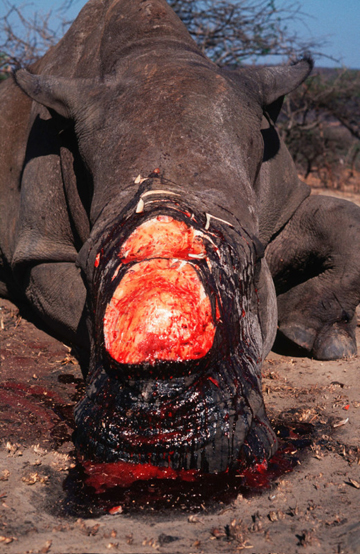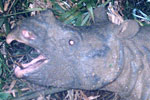WARNING: Graphic photo below.
Indian rhino with its horn sawed off. A cut-off horn may help keep poachers away, but doesn’t guarantee it. Photo: Rhett A. Butler.
Two months before the end of the year, the number of rhinos killed for their horns in South Africa has surpassed last year’s breaking record, reports conservation organizations WWF and TRAFFIC. So far, 341 rhinos have been lost to poaching this year; while last year saw a total record of 333. The news follows last week’s announcement that the Vietnamese rhino (Rhinoceros sondaicus annamiticus), a subspecies of the Javan rhino, has gone extinct—the last individual killed by a poachers’ bullet. Rhinos are killed for their horns which are used in traditional Chinese medicine, even though numerous studies have shown there is no medicinal benefit to consuming rhino horn.
“Since armed protection for rhinos in South African national parks is strong, poaching syndicates are likely to shift to countries with weaker enforcement power, possibly including Asian countries that may be caught off-guard,” warned Carlos Drews, Global Species Program Director at WWF, in a press release. “To break the illegal trade chain, governments in source, transit and consumer countries must all scale up their efforts.”
Poachers have focused on South Africa to date because it contains the world’s most rhinos, with nearly 2,000 black rhinos (Diceros bicornis) and over 18,000 white rhinos (Ceratotherium simum).
Experts say the rise in poaching around the world is linked to a rise in demand coming largely from Vietnam, the very country that has lost its last rhino to poachers. A rumor that rhino horn cured a Vietnamese official’s cancer appears to have propelled the demand. However, studies have shown that consuming rhino horn has pretty much the same medicinal benefit as eating one’s fingernails or hair, as both are made from keratin.
South Africa has responded to the poaching crisis by cracking down on poachers and handing out lengthy prison terms.
 A white rhino killed by poachers for its horn. Photo © Martin Harvey / WWF-Canon. |
“Vietnam should follow South Africa’s example and start sending poachers, traders, smugglers and sellers to jail,” says Joseph Okori, WWF’s African Rhino program coordinator. “In order to save rhinos from extinction, the criminal syndicates operating between South Africa and Vietnam must be uncovered and shut down for good.”
Experts also warn that Vietnam’s last tiger population is on the edge of extinction due to demand for tiger parts from traditional Chinese medicine. The black-market medicine trade has also played a role in declining bear, pangolin, and turtle populations, among other animals, in Asia’s forests. There are concerns that the trade is beginning to extend to lions in Africa, as well.
Poaching, along with habitat loss, has decimated rhino populations in Asia and Africa. Three of the world’s rhino species are listed as Critically Endangered by the IUCN Red List: the black, the Javan (Rhinoceros sondaicus), and the Sumatran (Dicerorhinus sumatrensis). Less than 50 Javan rhinos survive, all in a single park in Java, while around 250 Sumatran rhinos survive.
Beyond pushing one of the world’s most iconic animals to extinction, the trade has a human and societal toll: poachers have been killed in the act, while wildlife guards have lost their lives protecting rhinos. Still the criminal mafia at the top of the illegal trade remain unpunished.
Related articles
Vietnamese rhino goes extinct

(10/25/2011) In 2009 poachers shot and killed the world’s last Vietnamese rhinoceros (Rhinoceros sondaicus annamiticus), a subspecies of the Javan rhino, confirms a report from International Rhino Foundation (IRF) and the World Wide Fund for Nature (WWF). The Vietnamese rhino was the last Javan rhino to survive on the Asian mainland and the second subspecies to vanish, following the extinction of the Indian Javan rhino (rhinoceros sondaicus inermis). The Javan rhino is the world’s most imperiled rhino species with now only around 50 individuals surviving in a single park on its namesake island in Indonesia.
Eating rhino horn sends woman to hospital
(06/30/2011) A Vietnamese woman ended up in the hospital after consuming rhino horn, reports savingrhinos.org. Used for a rash around her mouth, the rhino horn instead caused a serious allergic reaction, including reddening skin, itching, and fever. Listed under the Convention on International Trade in Endangered Species of Wild Fauna and Flora (CITES), rhino horn is illegal to purchase or sell worldwide.
How do we save the Sumatran rhino?

(06/06/2011) Some conservation challenges are more daunting than others. For example, how do you save a species that has been whittled down to just a couple hundred individuals; still faces threats such as deforestation, poaching and trapping; is notoriously difficult to breed in captivity; and is losing precious time because surviving animals are so few and far-apart that simply finding one another—let alone mating and successfully bringing a baby into the world—is unlikely? This is the uphill task that faces conservationists scrambling to save the Sumatran rhino (Dicerorhinus sumatrensis). A new paper in Oryx, aptly named Now or never: what will it take to save the Sumatran rhinoceros Dicerorhinus sumatrensis from extinction? analyzes the conservation challenge, while putting forth a number of recommendations.